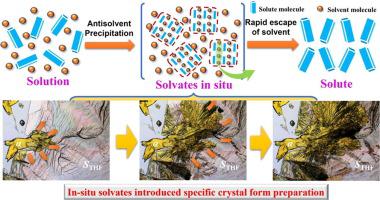Chemical Engineering Journal ( IF 13.3 ) Pub Date : 2022-12-21 , DOI: 10.1016/j.cej.2022.141052 Ying Wang , Dandan Han , Xiaoqing Zhou , Zhenqi Zhang , Junbo Gong , Hongzhen Li , Qi Zhang

|
Using energetic materials (EMs) products with impure solid forms in practical application scenarios will lead to a series of serious consequences in terms of safety, mechanics, storage, detonation, and reliability properties. A novel approach to obtain the scarce and superior performance solid form of EMs was developed by the strategy of rapid in-situ solvate-mediated phase transformation, which is a promising and convenient method because of avoiding additional desolvating under specific external conditions and greatly reducing the risks in the production of EMs. In this strategy, the low sensitivity and highly energetic material 4,4′,5,5′-tetranitro-1H,1′H-[2,2′-biimidazole]-1,1′-diamine (DATNBI) was used as a model substance and its α-DATNBI that is hard to gain but with better performance was successfully prepared. Furthermore, a mechanism of this solvate-mediated method was studied by exploring the types of solute clusters and intermolecular interaction of DATNBI in the microscopic view. These molecular assembly modes were determined in solid and solvents employing X-ray diffraction and in-situ micro-Raman technique, as well as attenuated total reflectance-Fourier transform infrared spectra combined with density functional theory calculation, respectively. It is found that solute molecules tend to exist as solvated monomers resulting in the prior precipitation of solvate in saturated solution of tetrahydrofuran (THF). From the perspective of crystal structure and transformation energy, the solvates consisting of DATNBI and THF can easily transform to the scarce α form of DATNBI. This study proposes a new practical strategy for a specific solid form mediated by solvates-mediated phase transformation, which is particularly beneficial for the preparation of high-purity solid forms of EMs with better energy and safety properties but also helps us to understand the key role of solvates in the polymorph formation.
.
中文翻译:

基于快速原位溶剂化介导的相变机制制备更高性能固体形式的 DATNBI
在实际应用场景中使用固体形态不纯的含能材料(EMs)产品,将在安全性、力学、储存、爆轰和可靠性等方面造成一系列严重后果。通过快速原位溶剂化物介导的相变策略开发了一种获得稀缺且性能优越的 EM 固体形式的新方法,这是一种有前途且方便的方法,因为它避免了在特定外部条件下的额外去溶剂化并大大降低了EM 生产中的风险。在此策略中,低灵敏度和高能量材料 4,4',5,5'-tetranitro-1 H ,1' H以-[2,2'-联咪唑]-1,1'-二胺(DATNBI)为模型物质,成功制备了其不易获得但性能较好的α-DATNBI。此外,通过在微观视图中探索溶质簇的类型和 DATNBI 的分子间相互作用,研究了这种溶剂化介导方法的机制。这些分子组装模式分别采用 X 射线衍射和原位显微拉曼技术以及衰减全反射-傅立叶变换红外光谱结合密度泛函理论计算在固体和溶剂中确定。发现溶质分子倾向于作为溶剂化单体存在,导致溶剂化物在四氢呋喃 (THF) 饱和溶液中预先沉淀。从晶体结构和转变能来看,由 DATNBI 和 THF 组成的溶剂化物可以很容易地转化为 DATNBI 的稀有 α 形式。本研究针对溶剂化物介导的相变介导的特定固体形式提出了一种新的实用策略,这特别有利于制备具有更好能量和安全性能的高纯度固体形式的 EM,同时也有助于我们理解其中的关键作用多晶型物形成中的溶剂化物。
.































 京公网安备 11010802027423号
京公网安备 11010802027423号